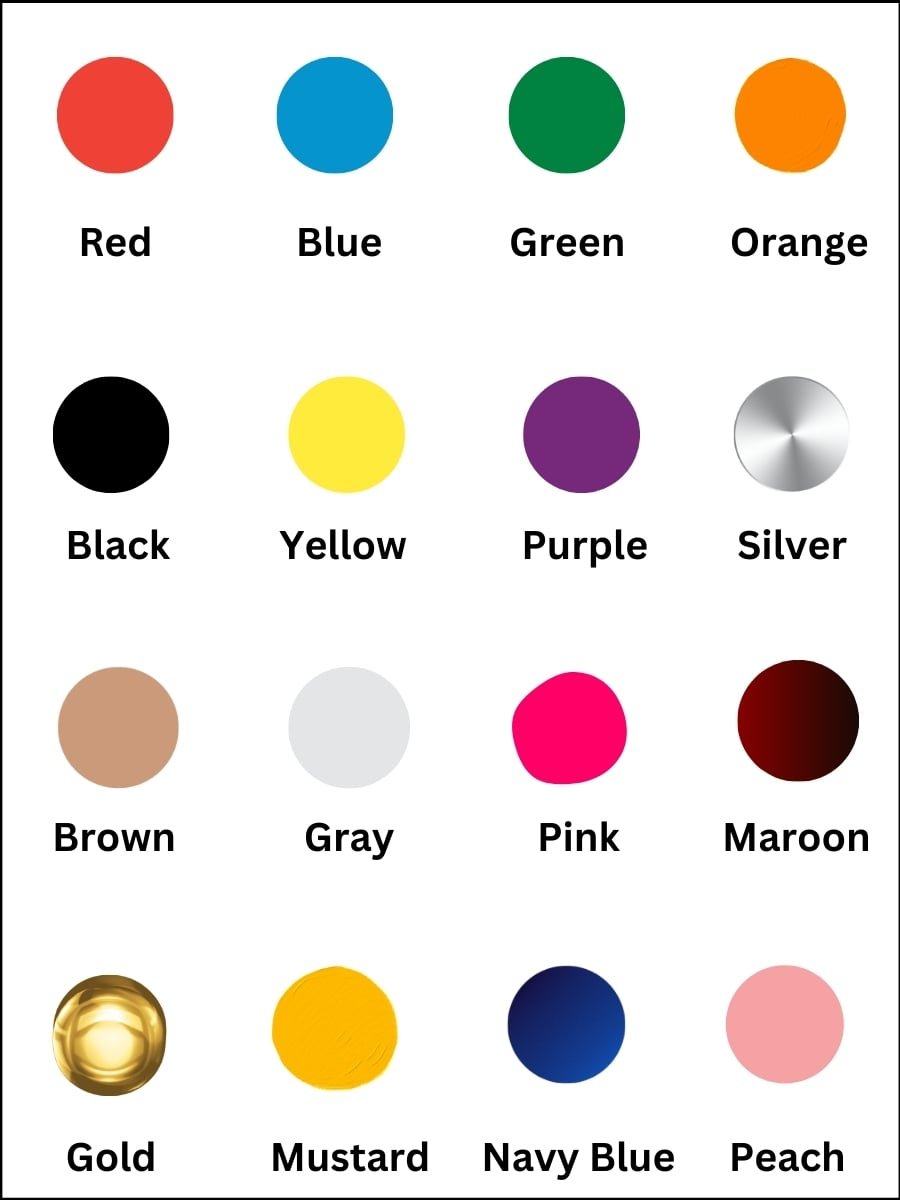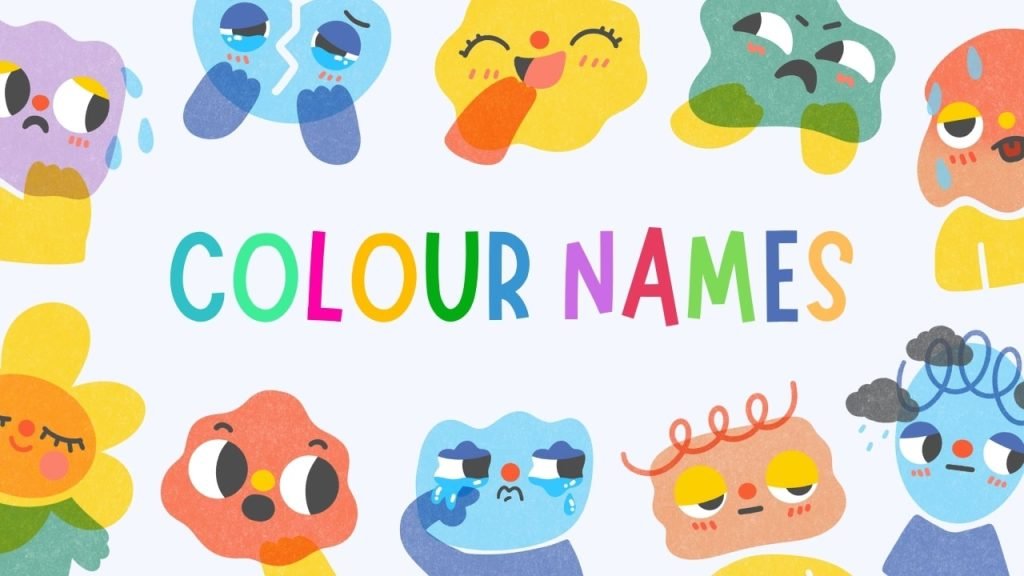Names of Colours
Colours are present everywhere in the world. Every object we see has a specific colour. As children, we learn the various names of colours, such as white, black, red, green, and blue. However, there are many more colours beyond these common ones. The concept of colour refers to how objects reflect light, which is then perceived by our eyes.
When light shines on an object, certain colours are reflected while others are absorbed. The reflected colours travel to our eyes, allowing us to identify them. Understanding colours is important for recognizing and describing the world around us.
Learning the Names of Colours
Colors are usually taught by linking them to things around us. For example, the sky is blue, and grass is green. Activities help people recognize colors, like spotting the color a word is written in instead of reading the word. These exercises improve thinking and observation skills while teaching color names.
Colors help us tell things apart, whether they are living or non-living. Knowing different color names is a helpful skill for everyday life.
Understanding Colour
The term “colour” refers to an aspect of objects described in terms of hue, lightness, and saturation. In physics, colour is associated with electromagnetic radiation that has specific wavelengths and intensities visible to the human eye. The colours we see are determined by the light reflected from objects and captured by the retina.

Types of Colours
Colours are classified into three main categories:
Primary Colours:
- Blue
- Red
- Yellow
Secondary Colours:
- Violet (a mix of red and blue)
- Orange (a mix of red and yellow)
- Green (a mix of blue and yellow)
Tertiary Colours:
- Blue-Violet
- Red-Violet
- Yellow-Green
- Red-Orange
- Yellow-Orange
- Blue-Green
Explore Our Resources
📕 Download PDF eBooks Combo – इंग्लिश स्पीकिंग कोर्स की सभी पुस्तकों की eBooks का सैट
📕 Download PDF eBooks Combo (Bangla Edition)
📕 Download PDF eBooks Combo (Urdu Edition)
-
-
-
-
-
-
-
-
-
-
-
-
- 📘 Buy Now – कम्प्लीट इंग्लिश स्पीकिंग कोर्स किट (सभी पुस्तकों का सैट + Lesson-wise वीडियो क्लासेज़ पैन्ड्राइव + नोट्स, प्रैक्टिस एवं क्विज़)
- 📚 Buy Now – इंग्लिश स्पीकिंग कोर्स की सभी पुस्तकों का सैट
- 💻 Buy Now – इंग्लिश स्पीकिंग कोर्स की Lesson-wise वीडियो क्लासेज़ पैन्ड्राइव + नोट्स, प्रैक्टिस एवं क्विज़)
- 🔴 Subscribe Now – YouTube (8M+ Subscribers)
-
-
-
-
-
-
-
-
-
-
-
List of Colour Names
Below is a list of names of colour and their corresponding hex codes:
| Name of Colours | Hex Code |
| Red | #ff0000 |
| Blue | #0000ff |
| Green | #00ff00 |
| Orange | #ffa500 |
| White | #ffffff |
| Black | #000000 |
| Yellow | #ffff00 |
| Purple | #800080 |
| Silver | #c0c0c0 |
| Brown | #a52a2a |
| Gray | #808080 |
| Pink | #ffc0cb |
| Olive | #808000 |
| Maroon | #800000 |
| Violet | #ee82ee |
| Charcoal | #36454f |
| Magenta | #ff00ff |
| Bronze | #cd7f32 |
| Cream | #fffdd0 |
| Gold | #ffd700 |
| Tan | #d2b48c |
| Teal | #008080 |
| Mustard | #ffdb58 |
| Navy Blue | #000080 |
| Coral | #ff7f50 |
| Burgundy | #800020 |
| Lavender | #e6e6fa |
| Mauve | #e0b0ff |
| Cyan | #e0f7fa |
| Peach | #ffe5b4 |
| Rust | #b7410e |
| Indigo | #4b0082 |
| Ruby | #e0115f |
| Lime Green | #32cd32 |
| Salmon | #fa8072 |
| Azure | #007fff |
| Beige | #f5f5dc |
| Copper Rose | #996666 |
| Turquoise | #40e0d0 |
| Aqua | #00ffff |
| Mint | #3eb489 |
| Sky Blue | #87ceeb |
| Crimson | #dc143c |
| Saffron | #f4c430 |
| Lemon Yellow | #fff44f |
| Arctic Blue | #0000ff |
| Ash | #808080 |
| Mocha | #c0a392 |
| Coffee Brown | #6f4e37 |
| Jet Black | #0a0a0a |
| Pista Green | #00ff00 |
| Umber | #635147 |
Descriptions of Common Colours
- Red: Found at the end of the visible spectrum of light. It is often linked to strong emotions.
- Blue: A primary colour that is widely used and easy to recognize.
- Green: Represents the colour of vegetation and natural surroundings.
- Orange: A combination of red and yellow. It is vibrant and noticeable.
- White: Commonly seen in objects that reflect most light.
- Black: The absence of light, often associated with formality and professionalism.
- Yellow: A bright colour that easily captures attention.
- Purple: Created by mixing red and blue. It is used in various contexts to stand out.
- Brown: A natural tone often found in wood and soil.
- Gray: A neutral colour that can blend with many other tones.
- Pink: Frequently associated with softness and gentleness.
- Olive: A greenish-yellow tone used in various applications.
- Maroon: A dark shade of red with hints of purple.
- Charcoal: A dark gray shade resembling ash.
- Magenta: A bright mix of red and blue tones.
Colours for Kids
Colours play an important role in education for children. Recognizing and naming colours is one of the first steps in early learning. Below are some colours commonly introduced to kids:
- Blue
- Green
- Yellow
- Orange
- Red
- White
- Violet
- Brown
- Aqua
- Black
- Cyan
- Purple
Activities like colouring, painting, and matching objects with colours help children become familiar with different shades and names.
FAQs About Colours
Q1. What are the three basic types of colours?
Ans. Primary colours: Blue, Red, Yellow, Secondary colours: Violet, Orange, Green, Tertiary colours: Blue-Violet, Red-Violet, Yellow-Green, Red-Orange, Yellow-Orange, Blue-Green.
Q2. Name some colour names starting with ‘B’.
Ans. Blue, Black, Brown, Bronze
Q3. List colour names starting with ‘G’.
Ans. Gold, Gray, Green
Q4. Provide some common colours for kids.
Ans. Blue, Yellow, Red, Green, Orange
Expanding the knowledge of colours helps in better visual understanding and creativity. This knowledge is useful for identifying and classifying objects in various fields, from art to science.
Explore Our Resources
📕 Download PDF eBooks Combo – इंग्लिश स्पीकिंग कोर्स की सभी पुस्तकों की eBooks का सैट
📕 Download PDF eBooks Combo (Bangla Edition)
📕 Download PDF eBooks Combo (Urdu Edition)
-
-
-
-
-
-
-
-
-
-
-
-
- 📘 Buy Now – कम्प्लीट इंग्लिश स्पीकिंग कोर्स किट (सभी पुस्तकों का सैट + Lesson-wise वीडियो क्लासेज़ पैन्ड्राइव + नोट्स, प्रैक्टिस एवं क्विज़)
- 📚 Buy Now – इंग्लिश स्पीकिंग कोर्स की सभी पुस्तकों का सैट
- 💻 Buy Now – इंग्लिश स्पीकिंग कोर्स की Lesson-wise वीडियो क्लासेज़ पैन्ड्राइव + नोट्स, प्रैक्टिस एवं क्विज़)
- 🔴 Subscribe Now – YouTube (8M+ Subscribers)
-
-
-
-
-
-
-
-
-
-
-
📚Trending Blogs📚
Tenses | Verbs | Prepositions | Conjunctions | Punctuation Marks | Active & Passive Voice
अगर आपको ये आर्टिकल (Names of Colours) पसन्द आया हो, तो इसे अपने दोस्तों के साथ WhatsApp, Facebook आदि पर शेयर जरूर करिएगा। Thank you! – Aditya sir


Gold Or orange